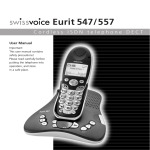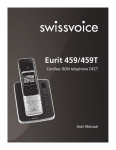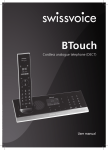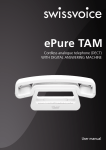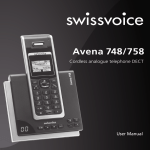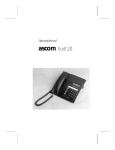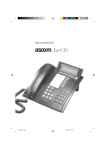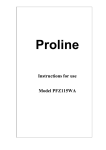Download Eurit 67 - Swissvoice.net
Transcript
Eurit 67 Corded ISDN telephone User Manual Important: This user manual contains safety precautions! Please read carefully before putting the telephone into operation, and store in a safe place. Safety precautions This corded telephone is designed for connection to the public ISDN network. Any other use whatsoever is not permitted and is regarded as in violation of the provisions. The user manual with safety precautions is a part of the product package and must be passed on to the new owner on reselling. Please note: ➭ Position the phone away from: – heat sources, – direct sun, – other electrical equipment. ➭ Protect your telephone against dust and avoid getting it wet or exposing it to aggressive liquids and steam. ➭ Do not plug the connection cord in sockets other than the one for which it is intended. ➭ Connect only authorised accessories. ➭ Clean the phone with a soft, damp cloth. Do not use abrasive cleaning agents or solvents. ➭ Do not position the telephone in bathrooms or showers. ➭ Do not touch open contacts! Disposal Please dispose of telephone and gift boxes in an ecological manner. Do not dispose of them in domestic waste. Contents Your Eurit 67 is designed for connection to the public ISDN network. Please read these operating instructions carefully to familiarise yourself with and take full advantage of the benefits of your new Eurit 67. Keep this user manual in a safe place! Note: These operating instructions describe the full range of functions provided by the Eurit 67. The functions and instructions described in this user manual may differ or be limited by the characteristics of your network operator or provider. For detailed information on the services available with your ISDN connection, contact your network provider. 20403219SIen_ba_a0 Safety precautions Setting up the telephone……………………………………………………………………7 Contents of the package ……………………………………………………………………7 Location ………………………………………………………………………………………7 Connecting the telephone ……………………………………………………………………8 Connecting the handset …………………………………………………………………8 Connecting the telephone ………………………………………………………………9 Installation assistant ……………………………………………………………………………9 Write-on label ………………………………………………………………………………10 Multiple Subscriber Numbers (MSN) ………………………………………………………11 Changing users …………………………………………………………………………11 1 Contents 20403219SIen_ba_a0 Getting to know your telephone ………………………………………………………12 Overview and operating elements …………………………………………………………12 Display symbols ………………………………………………………………………………14 About the menus ……………………………………………………………………………15 Menu navigation …………………………………………………………………………15 Back to previous menu …………………………………………………………………15 End menu …………………………………………………………………………………15 Telephoning …………………………………………………………………………………16 Call preparation ………………………………………………………………………………16 Accepting a call ………………………………………………………………………………16 Reject a call …………………………………………………………………………………16 Send DTMF/keypad information ……………………………………………………………16 Speed dialling …………………………………………………………………………………17 Handsfree/speakerphone ……………………………………………………………………17 Handsfree during a call …………………………………………………………………17 Listening by loudspeaker ……………………………………………………………………18 Handset volume ………………………………………………………………………………18 Telephone secrecy ……………………………………………………………………………18 Redial …………………………………………………………………………………………19 Redialling a number from the list ………………………………………………………19 Copying numbers from the redial list …………………………………………………19 Deleting individual entries/entire redial list ……………………………………………19 Sending SMS messages from the redial list* …………………………………………20 Keypad lock …………………………………………………………………………………20 Enquiries ………………………………………………………………………………………20 External enquiry call ……………………………………………………………………20 Brokering (switching between two calls) …………………………………………………21 Three-way conference ………………………………………………………………………21 * Function dependent on network operator. Contact your network operator to find out whether this service is supported. 2 Contents Directory………………………………………………………………………………………22 Directory entries ………………………………………………………………………………22 Adding a new entry ……………………………………………………………………22 Tips for entering names/numbers ………………………………………………………22 Editing entries ……………………………………………………………………………23 Deleting directory entries/entire directory ……………………………………………23 Dialling numbers from the directory ………………………………………………………23 Sending SMS messages from the directory* ………………………………………………23 VIP directory …………………………………………………………………………………24 Calls list* ……………………………………………………………………………………25 Viewing/dialling a number from the calls list ………………………………………………25 Sending SMS messages from the calls list* ………………………………………………25 Saving numbers from the calls list to the directory ………………………………………25 Deleting individual entries …………………………………………………………………26 Deleting the entire calls list …………………………………………………………………26 Audio …………………………………………………………………………………………27 Ringer …………………………………………………………………………………………27 Beeps …………………………………………………………………………………………27 Key beeps …………………………………………………………………………………27 Confirmation beep ………………………………………………………………………27 Family …………………………………………………………………………………………28 Direct call (baby call) …………………………………………………………………………28 20403219SIen_ba_a0 Call costs ……………………………………………………………………………………29 Cost of last call ………………………………………………………………………………29 Summary ………………………………………………………………………………………29 * Function dependent on network operator. Contact your network operator to find out whether this service is supported. 3 Contents Settings ………………………………………………………………………………………29 Type of display ……………………………………………………………………………29 Charge factor ……………………………………………………………………………29 Currency …………………………………………………………………………………29 Calender/clock ………………………………………………………………………………30 Appointments ………………………………………………………………………………30 Alarm …………………………………………………………………………………………30 Time/date ……………………………………………………………………………………30 20403219SIen_ba_a0 Network functions (supplementary services) …………………………………………31 Call forwarding ………………………………………………………………………………31 Unconditional ……………………………………………………………………………31 No reply …………………………………………………………………………………31 Busy ………………………………………………………………………………………31 Call anonymously (Identification restriction) ………………………………………………32 Conference assistant …………………………………………………………………………32 Parking ………………………………………………………………………………………32 Park/unpark ………………………………………………………………………………32 Park code …………………………………………………………………………………32 Recall …………………………………………………………………………………………33 Call back on busy (Completion of Calls to Busy Subscriber/CCBS) …………………33 Delete call back …………………………………………………………………………33 Malicious Call Identification (MCID) ………………………………………………………33 Call transfer …………………………………………………………………………………33 Network answer machine (Voicebox) ………………………………………………………34 Provider ………………………………………………………………………………………34 SMS ……………………………………………………………………………………………35 SMS – Short Messaging Service ……………………………………………………………35 Writing SMS messages ………………………………………………………………………35 Inbox …………………………………………………………………………………………36 Drafts …………………………………………………………………………………………36 4 Contents Outbox ………………………………………………………………………………………36 Templates ……………………………………………………………………………………37 Settings ………………………………………………………………………………………37 SMS service centre ………………………………………………………………………37 Send service ………………………………………………………………………………37 SMS alert on/off …………………………………………………………………………37 20403219SIen_ba_a0 Settings ………………………………………………………………………………………38 Language ……………………………………………………………………………………38 Display …………………………………………………………………………………………38 Contrast …………………………………………………………………………………38 Backlight …………………………………………………………………………………38 Telephony ……………………………………………………………………………………39 Automatic keypad ………………………………………………………………………39 Speed dial keys ………………………………………………………………………………39 Programming speed dial keys …………………………………………………………39 Changing a programmed speed dial key ………………………………………………39 System PIN ……………………………………………………………………………………40 PBX ……………………………………………………………………………………………40 MSN settings …………………………………………………………………………………40 Assigning an MSN ………………………………………………………………………40 PBX access ……………………………………………………………………………………41 Compatibility …………………………………………………………………………………41 Exchange Access Code EAC …………………………………………………………………41 Entering the EAC ………………………………………………………………………41 Functions ……………………………………………………………………………………42 Entering EAC on/off ……………………………………………………………………42 Automatic ECT …………………………………………………………………………42 5 Contents Maintenance …………………………………………………………………………………43 Reset …………………………………………………………………………………………43 Software version and update ………………………………………………………………44 Software version …………………………………………………………………………44 Software update …………………………………………………………………………44 Emergency operation ………………………………………………………………………45 Emergency operation on network termination unit …………………………………45 Emergency operation on a PBX …………………………………………………………45 General information ………………………………………………………………………46 Approval and conformity ……………………………………………………………………46 Warranty conditions …………………………………………………………………………46 Warranty Certificate ………………………………………………………………………47 20403219SIen_ba_a0 Write-on label ………………………………………………………………………………49 6 Setting up the telephone Contents of the package Eurit 67 ➭ 1 telephone Eurit 67 ➭ 1 handset ➭ 1 handset spiral cord ➭ 1 telephone connection cord ➭ 1 user manual ➭ 1 cyrillic transparency Location Place the Eurit 67 on an even, dry surface within range of the connection socket. If the selected position is too far from the connection socket, use an approved extension cable which you can buy at any specialist outlet. ➭ Make sure the telephone connection cord is safely stowed to prevent accidents. ➭ Do not plug the connection cord in sockets other than the one for which it is intended. ➭ Do not expose the telephone to direct sunlight. ➭ Protect the telephone against moisture. Do not position the telephone in rooms exposed to condensation, corrosive steam or excessive dust. Condensation can be present in basements, garages, conservatories or sheds. 20403219SIen_ba_a0 ➭ The ambient temperature must be between 5 °C and 40 °C. Position the telephone in a clean, dry and well-aired location. Choose a place which is stable, level, and not subject to vibrations. To avoid mutual interference, do not position the telephone in the immediate vicinity of electronic equipment such as hi-fi systems, office equipment or microwave ovens. Avoid positioning the telephone near heat sources such as heating elements or near obstacles. 7 Setting up the telephone Connecting the telephone The connection sockets for the handset and connection cord are located on the base of the telephone. Connect the handset first, then plug the telephone in to the jack. Connecting the handset The connectors at both ends of the spiral cord are the same size. Plug the connector at the longer, straight end of the cord into the socket on the telephone based ➀ marked with the handset symbol. 1 Press the cable into the cable duct ➁. To do this, use a flat, thin object to press the cord under the grips. 20403219SIen_ba_a0 Plug the connector at the other end of the spiral cord into the socket on the handset. 8 2 Setting up the telephone Connecting the telephone Plug the smaller of the two connectors on the telephone connection cord into the socket on the telephone base ➀ marked with the telephone symbol. Press the cable into the cable duct ➁. To do this, use a flat, thin object to press the cord under the grips. 2 1 Turn the telephone over again and set it on its feet. Replace the handset. Plug the larger connector at the other end of the telephone connection cord into the wall socket ➂. Lift the handset. You will hear the dialling tone. You can now telephone! ➭ Do not plug the connection cord in sockets other than the one for which it is intended. ➭ Make sure the telephone connection cord is safely stowed to prevent accidents. Installation assistant An installation assistant simplifies things for you by guiding you step by step through the setup procedure for your telephone. Follow the displayed instructions and enter the preferred language, all MSN numbers along with user name, as well as time and date. 20403219SIen_ba_a0 Note • The installation assistant will re-appear following a reset of the telephone (reset to default settings). • You can also enter the preferred language, MSNs, time and date in the corresponding menus. • Depending on the relevant default language you only have a limited choice of languages available in the settings menu (see chapter “Settings, Language”). 9 Setting up the telephone Write-on label The phone is delivered with the write-on label already inserted. The last page of this user manual contains additional labels for the speed dial keys. Cut a new label out whenever you need one. 1 2 Insert the cut-out label into the recess near the speed dial keys ➀. If you already know which numbers are to be assigned to these keys, you can complete the label now. Place the Perspex cover on the label field into the recess ➁ and press lightly until it fits into position. 20403219SIen_ba_a0 ➭ If you want to add other numbers or do not know at startup which numbers you will be using, you can easily remove the Perspex cover for subsequent modification. Lift the cover by placing a fingernail under the notch at its edge. Add the number(s) and replace the cover as described above. 10 Setting up the telephone Multiple Subscriber Numbers (MSN) When you ordered your ISDN connection, your network operator will have assigned you several Multiple Subscriber Numbers (MSN). You can assign these numbers to different devices or assign individual numbers to different users. Every MSN (user) can then define individual settings for the number assigned to him or her. Your telephone can manage up to 5 MSNs. To use all the functions, you must set up at least one MSN with user name (see section on “Assigning an MSN”). Changing users To change users, press the softkey under MENU. Use to scroll to CHANGE USER and select the relevant user. The current user is displayed. You can now access the activated user’s call lists, charge displays and individual settings. To find out how to set preferences for individual MSNs, refer to the section on “MSN settings”. The CHANGE USER menu can only be accessed if more than one MSN has been programmed. 20403219SIen_ba_a0 Note 11 Getting to know your telephone Overview and operating elements Handset Handset hook Smiley key Loudspeaker key Minus/Plus key Navigation key Calls list Softkey Redial Message key Softkey Eurit 67 Mute key Enquiry key Asterisk key/ Ringer on/off 20403219SIen_ba_a0 Loudspeaker 12 Alphanumerical keypad Hash key/ Activating the key lock Speed dial keys Speakerphone Getting to know your telephone Softkeys (multifunctional keys) Right softkey: Choose menu options, confirm entries/settings. Left softkey: return to previous menu step. Navigation key Redial For scrolling up/down or right/left Open redial list. Opens calls list*. Message key Access to new unanswered calls or new SMS messages. Loudspeaker key Listening by loudspeaker: Activate loudspeaker during a call for others in the room to listen in. Minus/Plus key Loudspeaker volume up/down. Mute key Deactivate microphone to ask a question in the room without your partner hearing you. … Alphanumerical keypad printed. For dialling telephone numbers. Letters Press and hold down “0” when entering a telephone number to insert a dialling pause between two digits. Voicebox Press and hold down for direct access to network answer machine messages. Call back on busy back on busy. Press and hold if called party is busy: Activate call Call anonymously call. Press and hold down to suppress caller ID for next Park / unpark Press and hold during call: Park. Press and hold in standby mode: Unpark. 20403219SIen_ba_a0 Asterisk key ringer on/off. For entering asterisks. Press and hold down to switch Hash key For entering the hash symbol. Press and hold down to switch keylock on. * Function dependent on network operator. Contact your network operator to find out whether this service is supported. 13 Getting to know your telephone Keypad locked inadvertently. Enquiry key Smiley key A locked keypad prevents numbers being dialled with flash function. Opens the VIP directory. 5 Speed dial keys (dual-programmable). Display symbols Alarm set Indicates that the alarm is set. Unanswered calls* Displayed if you have unanswered calls in the calls list. Active call Indicates that a call is in progress. You have new SMS messages* Indicates that you have new SMS messages. Ringer off Indicates that the ringer is switched off. You have voicebox messages Displayed if you have new voicebox messages. Keypad lock Indicates that the keypad is locked. Recall Offers you the option of “call back on busy”. 20403219SIen_ba_a0 Call forwarding activated Indicates that call forwarding is activated. * Function dependent on network operator. Contact your network operator to find out whether this service is supported. 14 Getting to know your telephone About the menus Menu navigation Your handset provides you with an easy-to-follow menu. As a rule, every menu offers a list of options. To select main menu, sub-menu and options, press the softkey below the corresponding display text. Press the softkey under MENU to open the main menu and use the navigation key to scroll to the option you are seeking. Press OK to open the options list, use the navigation key to scroll down the list to the preferred option, and confirm the option by pressing OK. Back to previous menu Press BACK to return to the previous menu. End menu 20403219SIen_ba_a0 To exit a menu, press the softkey under BACK. If you want to return to standby mode, press BACK again. 15 Telephoning Call preparation First, enter the number. If you enter an incorrect number, you can delete the entry. Lift the handset to dial the number. Accepting a call The caller's number or name (if stored in the directory) are displayed only if your network operator supports caller line ID (Caller Line ID Presentation/CLIP*). Lift the handset to accept the call. Reject a call You can reject an incoming call. Press the softkey under OPTION, REJECT, the caller is rejected. Send DTMF / keypad information By switching to temporary DTMF you can press the softkey under OPTION, DTMF to send control signals, e. g. for the voicebox, during a call. 20403219SIen_ba_a0 Note If you have activated “Autom. DTMF” in the SETTINGS, TELEPHONY menu, there is no need to switch to temporary DTMF. Temporary DTMF is automatically deactivated when you end the call. * Function dependent on network operator. Contact your network operator to find out whether this service is supported. 16 Telephoning Speed dialling Your telephone offers the option of dialling frequently used numbers by simply pressing a speed dial key. There are 5 keys available for this purpose. Each can be programmed twice to give a total of 10 numbers. The numbers stored under speed dial keys are available to all users. For speed dialling, the relevant speed dial key must be programmed with a telephone number. Press the speed dial key . Lift the handset. The telephone automatically dials the number. Wait for the connection and make your call. Note • Press the speed dial key once to display the first stored telephone number. Press the speed dial key twice to display the second stored number. • To programm speed dial keys, see chapter “Settings / Speed dial keys”. Handsfree / speakerphone You can conduct calls with the handset on-hook and allow others present in the room to take part in the call. Your phone rings to indicate an incoming call: Press to accept the call and conduct the call over the loudspeaker. Press again to terminate the call. 20403219SIen_ba_a0 Handsfree during a call Press and hold down speaker key now. Press during an active call. Replace the handset and release the loudagain to terminate the call. 17 Telephoning Listening by loudspeaker Unlike handsfree, others present in the room can listen in the call, your caller however only hears what is said through the handset (not what is said in the room). You are talking on the handset and want others in the room to listen in. Press to activate the loudspeaker. Press again to deactivate the loudspeaker. Replace the handset to terminate the call. Handset volume You can adjust the handset loudspeaker volume in 5 steps. Press during a call to adjust the volume. The selected setting is saved after the end of the call. Telephone secrecy During a call you can talk to someone else in the room without the caller hearing. during a call. This switches handset secrecy on and your caller cannot hear 2. Press to return to the call. 20403219SIen_ba_a0 1. Press you. 18 Telephoning Redial The 15 last-dialled numbers are saved in a redial list. If a name and number are already stored in the directory, the name is shown instead of the number. Redialling a number from the list Press to open the redial list and press to scroll through the list. Lift the handset as soon as you have reached the number you are seeking. Note If the redial list is empty, a message to this effect appears. Copying numbers from the redial list You can copy a number from the redial list to the directory. Press to open the redial list. Use to scroll through the list to find the number you are seeking, and press the softkey under OPTION. Enter the name and number and define your individual settings. Assign the entry to the relevant user and save. Note If the number is already in the directory, the Save function is not displayed. Deleting individual entries/entire redial list 20403219SIen_ba_a0 Press to open the redial list. Scroll through until you reach the entry you are seeking. Press the softkey under OPTION and delete the entry or the entire list. 19 Telephoning Sending SMS messages from the redial list* 1. Press the softkey under . Use to scroll through the list to find the entry you are seeking, and press the softkey under OPTION. 2. Write and send your SMS message. Keypad lock 1. Press and hold down . The display shows LOCKED. 2. To unlock the keypad, press the softkey under UNLOCK, then press Note . If the keypad is locked, • you can dial the emergency numbers (in call preparation only) and incoming calls can still be accepted. • you cannot dial a number or access menus. Enquiries External enquiry call Procedure: 1. You are conducting a call and want to call another external party without ending the active external call. 20403219SIen_ba_a0 2. Press the enquiry key to start the external enquiry. * Function dependent on network operator. Contact your network operator to find out whether this service is supported. 20 Telephoning Brokering (switching between two calls) You have two active calls (one is hold), one of which is on hold. You can switch between the two by brokering. 1. You are conducting two calls, one of which is on hold. 2. Press the softkey under OPTION, BROKERING to switch between the call partners. 3. Press the softkey under END, to end one of the calls. The remaining call partners are automatically connected with each other. Note You can connect all call partners together by pressing the softkey under OPTION, JOIN. Three-way conference You can use the conference assistant to set up a three-way conference with 2 external call parties. 1. Scroll to NET FUNCTIONS, CONFERENCE ASSISTANT and press OK to confirm. 2. Dial the number of the call partner or search for it in the directory. Once the connection is set up, tell the call partner that you are setting up a three-way conference call. The call partner is put on hold. 20403219SIen_ba_a0 3. Dial the number of the second call partner or search for it in the directory. The three-way conference call is activated as soon as the second call partner accepts the call. Note If the second call partner does not answer, you can return to the first call partner by pressing the softkey under END. 21 Directory You can store up to 100 names and numbers in the directory. Every entry contains a name and telephone number. Names can be up to 16 letters long and numbers up to 24 digits long. Directory entries Adding a new entry If the telephone is in standby mode: 1. Press the softkey under DIRECTORY. All entries are displayed in alphabetical order. 2. Press the softkey under OPTION. Enter the new name and number and define your individual settings. Assign the entry to the relevant user and save. Note If the directory is empty, a message to this effect is displayed. Tips for entering names/numbers • Press to insert a space, or to enter a symbol. • The available special characters appear in the lower display line. Press the relevant key to scroll through the characters. to switch between upper and lower case 20403219SIen_ba_a0 • When entering names, you can press lettering. 22 Directory Editing entries 1. Press the softkey under DIRECTORY. Use to scroll through the list to find the entry you are seeking, and press the softkey under OPTION. 2. Edit the name and/or number and save the entry. Deleting directory entries/entire directory You can delete individual entries or the entire directory. 1. Press the softkey under DIRECTORY. Use to scroll through the list to find the entry you are seeking, and press the softkey under OPTION. 2. Delete the entry or the entire list. Dialling numbers from the directory 1. Press the softkey under DIRECTORY. All entries are displayed in alphabetical order. 2. Use to scroll through the directory, select the entry you are seeking and lift the handset. The number is displayed and dialled. You can also search by name by entering the first letter of the name. Sending SMS messages from the directory* 1. Press the softkey under DIRECTORY. Use to scroll through the list to find the entry you are seeking, and press the softkey under OPTION. 20403219SIen_ba_a0 2. Write and send your SMS message. * Function dependent on network operator. Contact your network operator to find out whether this service is supported. 23 Directory VIP directory You can store 10 frequently-used numbers in the VIP directory. The VIP directory is stored under . The telephone is supplied with the VIP directory empty. To enter a number in the VIP directory, press , enter the name and number, and save. Numbers in the VIP directory can be deleted and/or edited at any time. Note • Press to scroll through the VIP directory. 20403219SIen_ba_a0 • To call a VIP number, select the number from the VIP directory and lift the handset. 24 Calls list* If your network operator supports caller line ID* (CLIP), the caller's number (unless withheld) is displayed before you accept the call. If you have received new calls, a message to this effect appears in the display. A list is kept of answered and unanswered calls. The calls list can hold up to 30 entries. If the list is full, the oldest entry is overwritten by the most recent entry. Note If the calls list is empty, a message to this effect is displayed. Viewing/dialling a number from the calls list Press to open the calls list. Press the number. to scroll through the list. Lift the handset to dial Sending SMS messages from the calls list* 1. Press to open the calls list. Use to scroll through the list to find the entry you are seeking, and press the softkey under OPTION. 20403219SIen_ba_a0 2. Write and send your SMS message. * Function dependent on network operator. Contact your network operator to find out whether this service is supported. 25 Calls list* Saving numbers from the calls list to the directory 1. Press . Scroll through until you reach the entry you are seeking. 2. Press the softkey under OPTION, SAVE NUMBER. Enter the name for the associated number and define your individual settings. Assign the entry to the relevant user and save. Deleting individual entries 1. Press . Scroll through the relevant calls list (for answered and unanswered calls) until you reach the entry you are seeking. 2. Press the softkey under OPTION, DELETE CALL and delete the entry. Deleting the entire calls list 20403219SIen_ba_a0 Press and DELETE ALL CALLS to delete the entire list. * Function dependent on network operator. Contact your network operator to find out whether this service is supported. 26 Audio Procedure: 1. Press the softkey under MENU. Press to scroll to AUDIO ad press OK to confirm. 2. Scroll to the relevant submenu and make the relevant settings: Ringer You can programme different ringer melodies for each MSN. Choose from 10 standard ringer melodies. Set the preferred ringer melodies and associated volume. You can also set an ascending volume. Beeps Your telephone supports various tones which you can activate or deactivate: Key beeps Every time a key is pressed, a brief beep is heard. Confirmation beep 20403219SIen_ba_a0 Settings and entries are confirmed by a short beep. 27 Family Procedure: 1. Press the softkey under MENU. Press to scroll to FAMILY and press OK to confirm. 2. Scroll to the relevant submenu and make the relevant settings: Direct call (baby call) If you activate direct call on your telephone, the telephone dials a preprogrammed number when any key is pressed. “Direct call” can be very useful, especially for parents with young children. If the parents are not at home, the children can reach their parents (or neighbours) simply by pressing any key on the telephone. The direct call number must be preprogrammed by the parents beforehand. You must deactivate the direct call function to restore your telephone’s normal functions. 20403219SIen_ba_a0 Note 28 Call costs Procedure: 1. Press the softkey under MENU. Press to scroll to CHARGES and press OK to confirm. 2. Scroll to the relevant submenu and make the relevant settings: Cost of last call You can display the cost of the last call as well as call charges per MSN or handset. Summary You can display the total per handset and for all MSNs. Settings Type of display You can display the cost or duration of a call. The following settings must be made before you can display costs: Charge factor To display costs accurately, you must set the charge per unit (factor). This factor is automatically transmitted for every outgoing call in the ISDN network. Currency 20403219SIen_ba_a0 To display costs accurately, you may need to set the currency. Note • Note that for technical reasons the displayed charges may differ from the amount billed. The amount indicated on your phone bill is binding. • If you are using a provider, charge information may not be available. 29 Calender/clock Procedure: 1. Press the softkey under MENU. Press to confirm. to scroll to CALENDAR/CLOCK and press OK 2. Scroll to the relevant submenu and make the relevant settings: Appointments Your telephone also acts as an appointments reminder: You can set 5 different appointment reminders. A signal is heard on the telephone at the defined time. Alarm To set the alarm, you need to activate the alarm function and enter the time and preferred alarm melody. You can choose from 10 standard alarm melodies. Time/date The time and date are automatically set when an outgoing call is made. Note • If the power supply is cut, the settings are lost and must be reprogrammed. 20403219SIen_ba_a0 • You can also set the time format (12/24 hours). 30 Network functions (supplementary services) Network functions are dependent on your network operator. Find out about availability and charges, if applicable. Procedure: 1. Press the softkey under MENU. Press to confirm. to scroll to NET FUNCTIONS and press OK 2. Scroll to the relevant submenu and make the relevant settings: Call forwarding Call forwarding allows callers to reach you even if you are not near your own telephone. Activate call forwarding for each MSN. Choose the relevant type of call forwarding (unconditional, no reply, busy) in the submenu SWITCH ON or SWITCH OFF and enter the forwarding number (i.e. the number to which calls are to be forwarded). Unconditional Incoming calls are forwarded immediately. No reply Incoming calls are forwarded after a delay (fixed time or number of rings). Busy Calls are forwarded if the line is busy. 20403219SIen_ba_a0 At any time you can: • check the call forwarding status • edit or delete the forwarding number • deactivate call forwarding. 31 Network functions (supplementary services) Call anonymously (Identification restriction) When you call someone, your number is shown on the other person's phone if it supports this function. You can program your MSN so that your calling line ID is suppressed (see section on “MSN settings”). “Anonymous call” for the next call only can also be activated in the relevant menu or by pressing and holding down the key . “Anonymous call” can also be assigned to a directory entry. Conference assistant See section on “Three-way conference”. Parking Park/unpark You can park an external call for 3 minutes and retrieve it on another telephone with the same connection. Press and hold during the call: Park. Press and hold in standby mode: Unpark. Park code 20403219SIen_ba_a0 Your telephone is delivered with the park code preset to 1. You can change the park code in the relevant menu. Press SAVE to confirm. The park code is used to clearly identify the parked connection, and must be entered when unparking. 32 Network functions (supplementary services) Recall This service is dependent on your network operator. Call back on busy (Completion of Calls to Busy Subscriber / CCBS) If a number you have dialled is busy, you can activate call back by pressing the softkey under CCBS or by pressing and holding down (the acitvated call back is signalled in the display with ). If call back on busy is activated, a special signal is heard as soon as the called party has replaced the receiver i.e. as soon as his or her line becomes free. Delete call back An activated callback can be deactivated (= deleted) in the relevant menu. Malicious Call Identification (MCID) This service is available from your network operator on request. Once your network operator has activated the service, malicious calls are registered during the call and up to 20 seconds after the receiver is replaced. The exchange registers the calling number, date and time, even if the caller has withheld his or her number. Call transfer 20403219SIen_ba_a0 You can transfer an incoming call to another telephone directly by pressing the softkey under OPTION, CD. 33 Network functions (supplementary services) Network answer machine (Voicebox) Many network operators offer the option of setting up a network answer machine (voicebox). Check whether this network function is available, the associated charges (if applicable) and the functions provided by this service. is displayed to alert you to new messages. To access new messages quickly and simply, press and hold down for around 2 seconds to automatically dial the access number of your network answer machine. Note • You can edit the network answer machine access number (Voicebox) in the submenu VOICEBOX, SETTINGS. • To use the network answer machine, you need to send certain codes to the network. Ask your network operator for details. Provider You can also make calls over another provider. 20403219SIen_ba_a0 Under PROVIDER LIST, enter the names and prefixes of the providers (max. 5) to whose service you have subscribed. You can link every directory entry to one of the providers in this list. If you want to make all calls over a single provider, scroll to DEFAULT PROVIDER in the submenu SETTINGS and enter the relevant provider's prefix. The default provider prefix is then automatically inserted before every number you call from lists (even if you have not saved a provider prefix in the directory entries). Note The default provider prefix is only inserted automatically if you dial from a list (directory, calls list, redial). 34 SMS SMS – Short Messaging Service Sending and receiving SMS messages is a network function. To send and receive SMS messages, your telephone line must have active Caller Identification Presentation (CLIP) and Connected Line Presentation (COLP)*. Check with your network operator to find out whether the SMS network function is available and about charges, if applicable. Your telephone supports SMS messages up to 612* characters in length. You can save up to 25 SMS messages in your lists. Note • Find out from your network operator whether you need to send an SMS message to subscribe to or unsubscribe from the SMS service. • To be able to send SMS messages, your number must not be withheld. • To be able to send SMS messages, your telephone must not be connected to a private branch exchange. Procedure: 1. Press the softkey under MENU. Press to scroll to SMS and press OK to confirm. 2. Scroll to the relevant submenu and make the relevant settings: Writing SMS messages 20403219SIen_ba_a0 Write your message. Refer to the chapter on “Directory entries” for tips on writing. You can also use symbols and templates in the menu SMS, WRITE MESSAGE. * Function dependent on network operator. Contact your network operator to find out whether this service is supported. 35 SMS Inbox New SMS messages are signalled in the display by and saved in the inbox. Press the softkey under INBOX to read new SMS messages. Or BACK, to read SMS messages later. Once you have read the SMS messages, you can answer, forward, save or delete them, or call the sender. Note If you have no SMS messages in your inbox, a message to this effect is displayed. Drafts You can create and save a draft SMS for subsequent sending, and edit and send it whenever you wish. Outbox Sent SMS messages are automatically saved in your outbox. You can edit and forward SMS messages in the outbox or call the recipient. Note • You can accept calls while writing an SMS. 20403219SIen_ba_a0 • If the SMS is not transmitted, a message to this effect is displayed and the SMS is saved in the outbox. You can delete the unsent SMS message to return to standby mode, or select "read" to open the SMS message and re-send it. 36 SMS Templates To simplify writing SMS messages, you can create up to 5 templates. You can edit and delete these templates or create a new SMS message template. Settings SMS service centre Before you can send and receive SMS messages, an SMS service centre must be programmed with the associated access number. Your phone is delivered with this number preset. Ask your network operator for details of these service numbers. Send service Select which service centre you want to use for sending SMS messages. SMS alert on/off 20403219SIen_ba_a0 If activated, a brief beep is heard every time a new SMS message is received. 37 Settings Language Procedure: 1. Press the softkey under MENU. Press and press OK to confirm. to scroll to LANGUAGE in the SETTINGS menu 2. Set the preferred display language. Display texts will appear in the set language. Depending on the relevant default language you only have a limited choice of languages available in the settings menu: • Default language: English/German/Slovenian ➞ Settings menu: English/German/Slovenian • Default language: Russian ➞ Settings menu: English/Russian To have the full choice of languages again, you need to reset your Eurit 67 (see chapter “Settings, Maintenance, Reset”). Note A reset deletes all your preferences, lists, and directory entries. Display Procedure: 1. Press the softkey under MENU. Press and press OK to confirm. to scroll to DISPLAY in the SETTINGS menu 2. Scroll to the relevant submenu and make the following display settings: Contrast 20403219SIen_ba_a0 To optimise legibility, you can adjust the display contrast. Backlight You can activate or deactivate backlighting for the display. 38 Settings Telephony Automatic keypad If the asterisk or hash key is pressed before dialling, the telephone automatically switches to “keypad signalling” (default setting: on). In some PBXs e.g. those in which automatic EAC selection is activated, you need to deactivate automatic keypad sending to initate internal calls by pressing the asterisk key. Speed dial keys Programming speed dial keys Press the relevant speed dial key once to enter a telephone number on the first level. Press twice to enter a number on the second level. Enter name and number and define your individual settings. Assign the entry to the relevant user and save. Changing a programmed speed dial key Press the softkey under MENU. Scroll to SPEED DIAL KEYS in the SETTINGS menu and press OK to confirm. Change the relevant speed dial entry and save the entry. Your telephone is delivered with none of the speed dial keys preprogrammed. 20403219SIen_ba_a0 Note 39 Settings System PIN Procedure: 1. Press the softkey under MENU. Press menu and press OK to confirm. to scroll to SYSTEM PIN In the SETTINGS 2. Change the existing system PIN as required. Note • We recommend that you change the system PIN to protect your telephone against unauthorised access. • Attention: Please take good note of your new system PIN! If you forget it, your network operator will need to intervene and will charge you for this service. PBX See “PBX access”. MSN settings Assigning an MSN Your telephone can manage up to 5 Multiple Subscriber Numbers (MSN). You must have at least one MSN programmed in order to use your telephone. 1. Press the softkey under MENU. Press to scroll to SETTINGS and press OK to confirm. 20403219SIen_ba_a0 2. Select the relevant MSN in the menu MSN SETTINGS. Program the MSNs and associated user names, and activate/deactivate the functions “Anonymous call” and “Call waiting”. If you are already on the telephone, the “Call waiting” function emits an acoustic signal to alert you to an incoming call. Note • You can also use the installation assistant to set up your MSNs and define the associated settings. • The MSNs must be programmed without a prefix. 40 PBX access Compatibility You can also connect your telephone to an ISDN private branch exchange. The functionality is dependent on your PBX type. Contact your network operator for further information. Exchange Access Code EAC You may need to enter an exchange access code (e.g. 0) to allow the public exchange to assign an external line for external calls or for calling back numbers in the calls list. Entering the EAC Procedure: 1. Press the softkey under MENU. Scroll to PBX, ACCESS CODE in the SETTINGS menu and press OK to confirm. 2. Enter the exchange access code. Note • After having programmed an exchange access code you do not have to enter it again in a directory entry. However, if you dial off-hook or in call preparation you still have to enter the exchange access code manually. • To give the exchange sufficient time to assign a public line, you may need to program a “pause” after the exchange access code by pressing and holding down . 20403219SIen_ba_a0 • For further information, refer to your PBX operating instructions. 41 PBX access Functions Entering EAC on/off If the EAC automatically is set for connected line presentation, you have to activate this function to be able to call back from the calls list directly. Make the relevant settings (on or off) in the PBX, FUNCTIONS menu. Automatic ECT To transfer calls internally over the PBX network, you may need to set a transfer type. The type of transfer (functional or with disconnect) depends on your PBX. The telephone is delivered with ECT on (functional). 20403219SIen_ba_a0 Refer to the PBX, FUNCTIONS menu to make the relevant settings (“ECT on” for functional and “ECT off” for disconnect). 42 Maintenance Reset You can reset the telephone to default status as follows: Procedure: 1. Press the softkey under MENU. Scroll to MAINTENANCE in the SETTINGS menu. Press OK to confirm. 2. Press RESET and press OK to confirm. The default settings are restored. Note • A reset deletes all your preferences, lists, and directory entries. 20403219SIen_ba_a0 • After a reset, the installation assistant re-appears. 43 Maintenance Software version and update Procedure: 1. Press the softkey under MENU. Scroll to SPEED DIAL KEYS in the SETTINGS menu and press OK to confirm. 2. Scroll tho the relevant submenu and make the relevant settings. Software version You can display the name and the latest software version installed in your phone. Software update The software of your telephone is continually adapted to the state of the art. You can download the latest software to your phone in a matter of minutes via the telephone line. If you already have the most recent software version installed in your phone, the connection is cleared within a few seconds. The access number (0041848888088) for remote download is saved in the phone. You can change the access number in the SETTINGS submenu. Note • If the remote download fails, a new access number may need to be set. If in doubt, contact your network operator. 20403219SIen_ba_a0 • Under no cicumstances unplug the connection cable from the telephone during a download. 44 Maintenance Emergency operation One of your phones can still be operated in emergency mode during power failures (emergency operation). You have to switch ON the emergency operation on the base of the telephone that is used for emergency operation. Your telephone is delivered with the emergency operation deactivated (OFF). Emergency operation on network termination unit Emergency operation switch The emergency power is supplied directly by the exchange and provides sufficient power for just one telephone. Not all features are available in emergency mode. However, you can still make and receive calls. On Off To set a telephone for emergency operation, switch ON the emergence operation on the base of the telephone. Note You may set only one telephone for emergency operation: If you set more than one telephone for emergency operation, none of the telephones are able to function! 20403219SIen_ba_a0 Emergency operation on a PBX If your phone is connected to a PBX, the system supplies the emergency power. The type of PBX dictates which features are available during emergency operation and how many phones are capable of emergency operation. Refer to your PBX documentation. Note For PBX operation you still need to enable your phone for emergency operation (emergency operation switched ON). 45 General information Approval and conformity This corded ISDN telephone complies with the basic requirements contained in the R&TTE Directive 1999/5/EC on radio equipment and telecommunications terminal equipment and is suitable for connection and operation in the member state indicated on the base station and/or packaging. The declaration of conformity may be viewed at: www.swissvoice.net. The CE symbol confirms the conformity of the telephone with the above directive. Warranty conditions Your telephone is subject to a guarantee from the date of purchase in accordance with the legal provisions of the country in which the telephone was purchased. As evidence of the date of purchase, please keep the receipt or the warranty card completed by the retailer. All defects attributable to material and manufacturing faults will be corrected free of charge within the warranty period, either by repairing or replacing the defective equipment. The warranty does not cover expendable materials (battery cells), defects which affect the value or use of the equipment only insignificantly, and damage caused by incorrect use, ordinary wear and tear, or manipulation by third parties. 20403219SIen_ba_a0 This warranty does not cover consequential damage caused by the use, failure or defectiveness of the product. In particular, no liability whatsoever is accepted for damage to property and pecuniary loss. To claim under this warranty, please contact the retailer where you purchased your telephone. 46 Warranty Certificate Warranty Certificate Garantieschein, Bon de garantie, Certificato di garanzia, Garantiebewijs, Takuutodistus, Garantibevis, Garantisedel, Garantibevis, Certificado de Garantía, Talão de garantia device type: (Gerätetyp, type d’appareil, tipo di apparecchio, toesteltype, laitetyyppi, maskintype, apparattyp, apparattype, modelo del aparato, modelo do aparelho): serial number: (Seriennummer, numéro de série, numero di serie, serienummer, sarjanumero, serienummer, serienummer, serienummer, número de serie, número de série): dealer’s stamp: (Händlerstempel, sceau du vendeur, timbro del rivenditore, stempel van de dealer, kauppiaan leima, forhandlerens stempel, försäljarens stämpel, forhandlerstempel, sello del comerciante. carimbo do vendedor): dealer’s signature: (Unterschrift des Händlers, signature du vendeur, firma del rivenditore, handtekening van de dealer, kauppiaan allekirjoitus, forhandlerens underskrift, försäljarens underskrift, forhandlers underskrift, firma del comerciante, assinatura do vendedor): date of purchase: (Kaufdatum, date d’achat, data d’acquisto, datum van aankoop, ostopäiväys, kjøpsdato, datum för köpet, salgsdato, fecha de adquisición, data de compra): 47 ✄ 48 20403219SIen_ba_a0 20403219SIen_ba_a0 Write-on label 49 50 20403219SIen_ba_a0 51 20403219SIen_ba_a0 52 20403219SIen_ba_a0 53 20403219SIen_ba_a0 54 20403219SIen_ba_a0 55 20403219SIen_ba_a0 56 20403219SIen_ba_a0 Internet: www.swissvoice.net © Swissvoice AG 2005 All rights as well as delivery possibilities and technical changes reserved. 20403219SIen_ba_000_a0 SV 20403219




























































